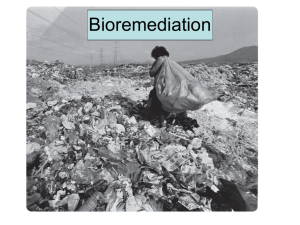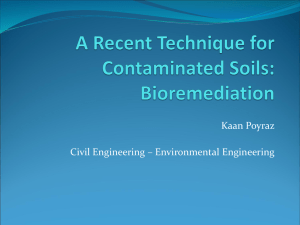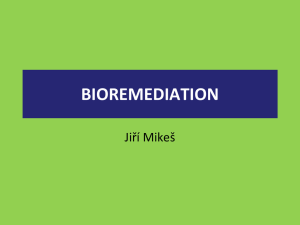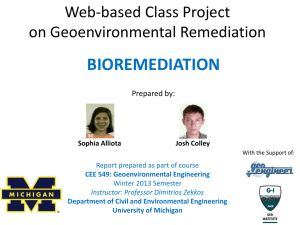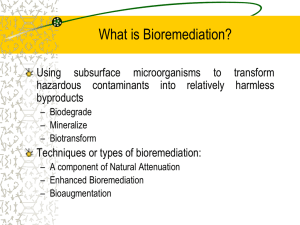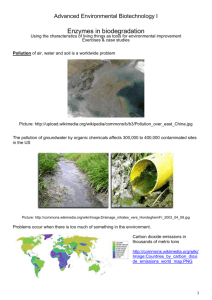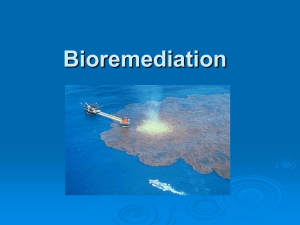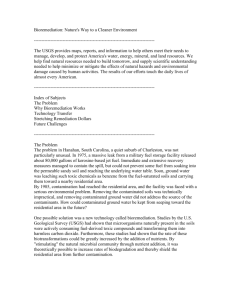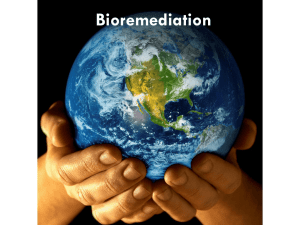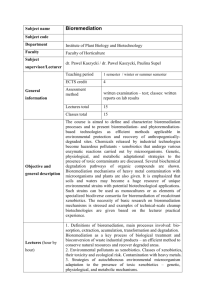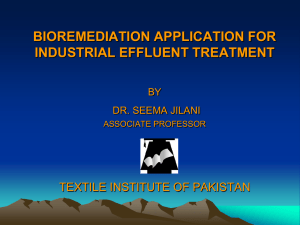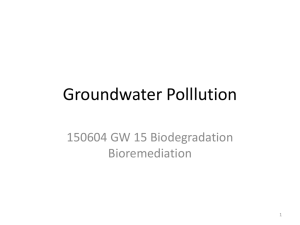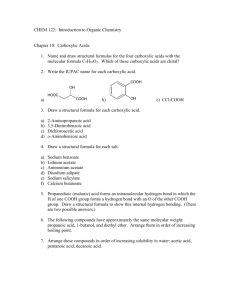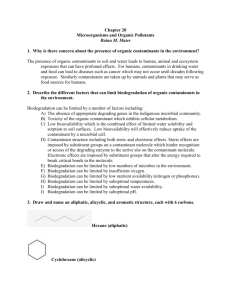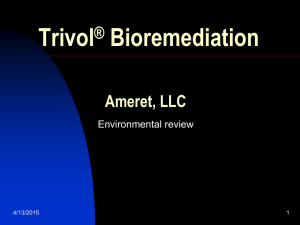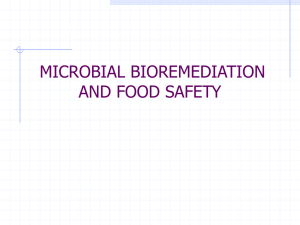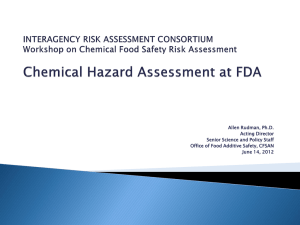Lecture 9
advertisement
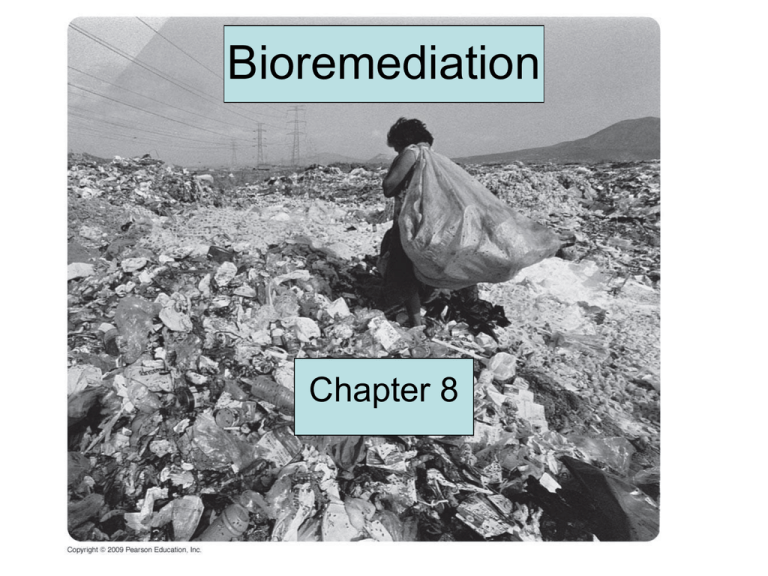
Bioremediation Chapter 8 What is bioremediation? The use of bacteria and fungi and plants to break down or degrade toxic chemical compounds that have accumulated in the environment What are environmental contaminants? • Pollutants – naturally-occurring compounds in the environment that are present in unnaturally high concentrations. – Examples: • • • • crude oil refined oil phosphates heavy metals • Xenobiotics – chemically synthesized compounds that have never occurred in nature. – Examples: • pesticides • herbicides • plastics Early examples of bioremediation • Outhouse→Centralized engineered wastewater treatment systems – Microorganisms oxidize organic waste molecules to carbon dioxide and water – Why do we want to use engineered manmade for this? More recent examples • By 1970s it became apparent that we were polluting the environment faster than the natural microbial processes could degrade the pollutants – Congress established the Environmental Protection Agency • Identified “Superfund Sites” that had priority over other polluted systems for special funding and cleanup in 1980 – 1 in 5 Americans lives within 3-4 miles of a polluted site treated by the EPA – Not much progress has been made even though $billions has been spent Sources of Contamination Municipal wat er well pond Leaking pet roleum tank Ocean W ater t able Fresh wat er Saline W ater septic t ank leakage Lat eral intrusion of saline wat er Infiltrat ion of pesticides and fert ilizers from farmlands Brine leakage from ruptured well casing Municipal landf ill Cont aminat ed shallow well Accidental fuel spill Conf ining Unit Conf ining Unit Abandoned oil well Leakage f rom hazardous waste site Deep Aquif er • Industrial spills and leaks • Surface impoundments • Storage tanks and pipes • Landfills • Burial areas and dumps • Injection wells Groundwater contamination • Groundwater constitutes 96% of available freshwater in U.S. • 95% of potable water in rural areas of U.S. comes from groundwater • In 1988, EPA confirmed that 26 states had various amounts of 44 different pesticides in their groundwater • Cost of cleanup is in the $ trillions • Issues that are still hotly debated – How clean is clean? Most recent • National Institute of Environmental Health Sciences established the Environmental Genome Project – Study impact of environmental chemicals on human disease • Identify genes and their products that are sensitive to toxic chemicals in the environment • Identify genes that encode for products that detoxify the chemicals What types of treatment technologies are in use to remove contaminants from the environment? • • • • • • • • Soil vapor extraction air sparging bioremediation thermal desorption soil washing chemical dehalogenation soil extraction in situ soil flushing What Makes Bioremediation a Promising Approach? • permanence – contaminant is degraded • potentially low cost – 60-90% less than other technologies Why use Bioremediation? • No additional disposal costs • Low maintenance • Does not create an eyesore • Capable of impacting source zones and thus, decreasing site clean-up time Economics of in-situ vs. ex-situ remediation of contaminated soils • Cost of treating contaminated soil in place $80$100 per ton • Cost of excavating and trucking contaminated soil off for incineration is $400 per ton. • Over 90% of the chemical substances classified as hazardous today can be biodegraded. Fundamentals of Biodegradation • All organics are biodegradable, BUT biodegradation requires specific conditions • There is no Superbug • Contaminants must be bioavailable • Biodegradation rate and extent is controlled by a “limiting factor” Contaminants Potentially Amenable to Bioremediation ____________________________________________ Readily degradable ____________ _ Somewhat Difficult to Generally degradable degrade recalcitrant _____________ _____________ _____________ fuel oils, gasoline creosote, coal tars chlorinated solvents (TCE) dioxins ketones and alcohols pentachlorophenol (PCP) some pesticides and herbicides polychlorinated biphenyls (PCB) monocyclic aromatics bicyclic aromatics (naphthalene) What challenges exist for bioremediation of pollutants and xenobiotics? • Pollutants – may exist at high, toxic concentrations – degradation may depend on another nutrient that is in limiting supply • Xenobiotics – microbes may not yet have evolved biochemical pathways to degrade compounds – may require a consortium of microbial populations Fundamentals of cleanup reactions • Aerobic metabolism – Microbes use O2 in their metabolism to degrade contaminants • Anaerobic metabolism – Microbes substitute another chemical for O2 to degrade contaminants • Nitrate, iron, sulfate, carbon dioxide, uranium, technicium, perchlorate Metabolism of a Pollutant-degrading Bacterium Fe(III) ACETATE *Benzoate *Toluene *Phenol *p-Cresol *Benzene ATP *U(VI) *Co(III) *Cr(VI) *Se(VI) *Pb(II) *Tc(VII) CO2 Fe(II) *CCl4 *Cl-ethenes *Cl-aromatics *Nitro-aromatics Uranium reduction leads to uranium precipitation and immobilization U6+sol U6+sol U6+sol U4+insol U4+insol Volatile organic compounds (VOC) • These are major contributors to air pollution – Paint industry – Pharmaceutical industry – bakeries – printers – dry cleaners – auto body shops Cometabolism • Bacterium uses some other carbon and energy source to partially degrade contaminant (organic aromatic ring compound) contaminant degradation products bacterium corn starch CO2 + H2O Hard to degrade contaminants • Chlorinated hydrocarbons – solvents – lubricants – plasticizers – insulators – herbicides and pesticides. Chemicals that exist as ring structures, which have chlorine atoms attached are referred to as halogenated aromatics and are often toxic. Examples: chlorobenzoates 2, -4-dichlorophenoxyacetate chlorobenzenes Removal of the Cl atom is the rate-limiting step in the degradation of the halogenated aromatic. A dioxygenase enzyme is used to replace the Cl atom with an OH group. The process requires the presence of oxygen. Degradation of chlorinated hydrocarbons • Degradation of organic toxins requires the participation of entire biochemical pathways involving many enzymes coded for by many genes. • Some of the genes exist on the chromosome while other genes reside on plasmids. phenol OH cis, cis-muconate catechol pheA dmpX phenol hydrolase OH pheB OH dmpB dioxygenase COOH COOH succinate and acetyl CoA CO2 + H2O (monooxygenase) • Phenol-degrading dmp operon is regulated by DmpR, a NtrC-like positive regulator. The layout of the genes involved in chlorocatecholdegradation on the plasmid is similar to the layout of the catechol-degrading genes on the chromosome 3-chlorobenzoate COOH 3-chlorocatechol OH OH A 2-chloro-cis,cismuconate COOH C=O o COOH Cl OH dieneiactone Cl Cl COOH COOH succinate 3-ketoadipate A, pyrocatechase II B, muconate lactonizing enzyme II D COOH COOH O O D, hydrolase II COOH B maleylacetate Genetic engineering of bacteria to remove toxic metals from the environment New gene/transport proteins Hg2+ E. coli bacterium Hg2+-metallothein Hg2+→Hgo New gene/enzyme Hgo (less toxic form of metal) Phytoremediation • ≈350 plant species naturally take up toxic materials – Sunflowers used to remove radioactive cesium and strontium from Chrenobyl site – Water hyacinths used to remove arsenic from water supplies in Bangladesh, India Phytoremediation • Drawbacks – Only surface soil (root zone) can be treated – Cleanup takes several years Transgenic plants Royal Demolition eXplosive Gene from bacterium moved to plant genome Stimulates plant growth! Careers in Bioremediation • Outdoor inspection • Lab testing • Administration Government Employee Regulatory oversight Company employee Summary • Many factors control biodegradability of a contaminant in the environment • Before attempting to employ bioremediation technology, one needs to conduct a thorough characterization of the environment where the contaminant exists, including the microbiology, geochemistry, mineralogy, geophysics, and hydrology of the system
